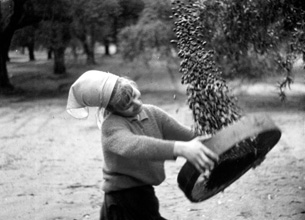Luigi di Gianni: Five Films
Luigi di Gianni
Italien 1958 -1967

|
Delphi |
Kamera: Claudio Racca
Format: 35 mm, s/w, 20’, 24 Bilder/Sek.
Il Messia
Kamera: Luigi Sgambati
Format: 35 mm, Farbe, 15’, 24 Bilder/Sek.
Il culto delle pietre
Kamera: Mario Carbone
Format: 35 mm, s/w, 18’, 24 Bilder/Sek.
Tempo de raccolta
Kamera: Claudio Racca
Format: 35 mm, Farbe, 12’, 24 Bilder/Sek.
Grazie e numeri
Kamera: Giuseppe de Mitri
Format: 35 mm, Farbe, 15’, 24 Bilder/Sek.
Magia lucana (1958) Ausgehend von einer magischen Beschwörung des Unwetters werden Alltagsbilder aus dem bäuerlichen Milieu in der süditalienischen Provinz Basilicata gezeigt: Landarbeit, Lebenssituationen und häusliche Armut.
Il Messia / Der Messias (1965) Zahlreiche Bewohner eines süd-italienischen Bergdorfes sind 1935 zum Judentum konvertiert und später zum Teil nach Israel ausgewandert. Der charismatische Kult um den Gründer Maduzio wird hier in Zusammenhang mit der Erlösungshoffnung der südländischen Religion gesehen. Ein bizarrer Fall der Religionsgeschichte.
Il culto delle pietre / Der Kult der Steine (1967) In Raiano wird jedes Jahr das Fest von San Veneziano gefeiert. Der Heilige lebte in den Höhlen rund um das Dorf, deren Steine seither eine therapeutische Kraft besitzen sollen. Neben den offiziellen Feiern ist der ‚Kult der Steine’ das geheimste und älteste Ritual. Einer der besten Filme Luigi de Giannis.
Tempo de raccolta / Zeit der Ernte (1966) Junge Frauen sammeln in wahnwitzigem Tempo Oliven vom Boden auf und schütten sie in Körbe. Ein eindringlicher Film über die Arbeit des Olivensammelns in Kalabrien, einer der wenigen wirklich gelungenen Filme über bäuerliche Mühe und Arbeit, über Ausbeutung und Kargheit.
Grazie e numeri / Anmut und Nummern (1962) Familienszenen, Alltagsleben in der neapolitanischen Unterschicht. Magische Praktiken in Neapel, vor allem der Kult um die Geister aus dem Purgatorium. Und das Porträt eines Mannes, der vom Weihrauchspenden lebt. Lottospieler und Lottomagier.
Magia lucana Opening with a magical ceremony to prevent storms, the film depicts scenes of peasant life in the southern Italian province of Basilicata: agricultural work, living situations and poverty in people’s homes, magic rituals.
The Messiah The film deals with a bizarre case from the history of religions. In 1935, many inhabitants of a mountain village in southern Italy converted to Judaism, and some of them emigrated to Israel after the war. The cult of the charismatic founder Maduzio is linked to the hope for redemption in southern religions.
The Cult of the Stones At Raiano the festival of San Veneziano is celebrated every year. The saint lived in the caves around the village, and according to tradition, the stones of the caves themselves acquired therapeutic proprieties. Along with the official celebrations, the cult of the stones is the most secret and the most ancient one.
Time of the Harvest An intense film about the work of olive collecting in Calabria, it is one of the few really good films about peasant’s work, exploitation and austerity. It shows young women collecting olives at amazing speed.
Grace and Numbers Family scenes and everyday life in the lower strata of Naples society. Some magic Neapolitan practices, particularly the cult of the spirits of purgatory. The portrait of a man who makes his living by distributing incense.